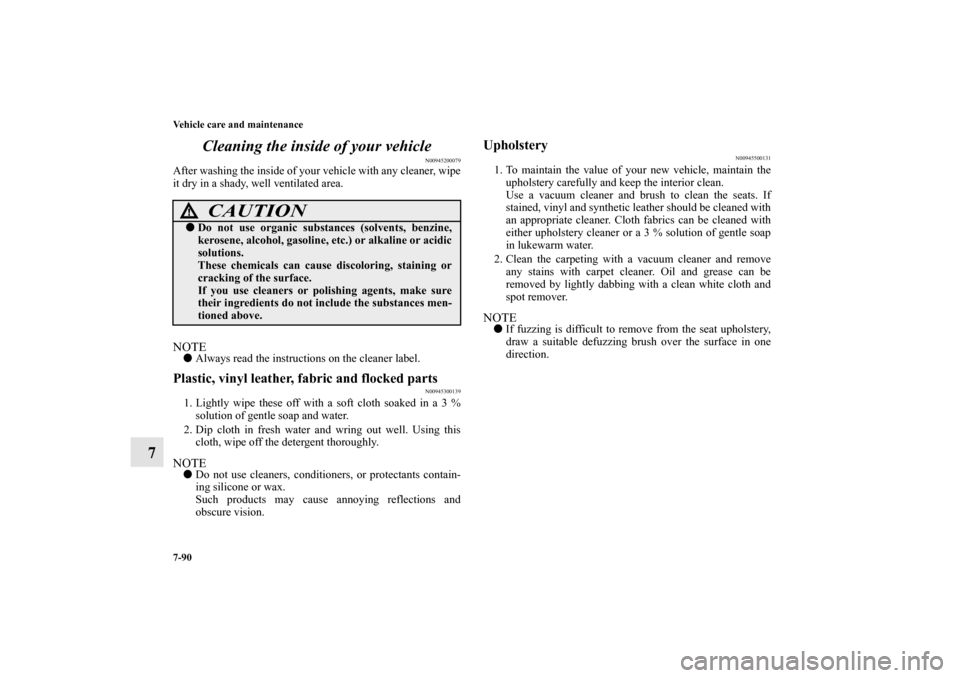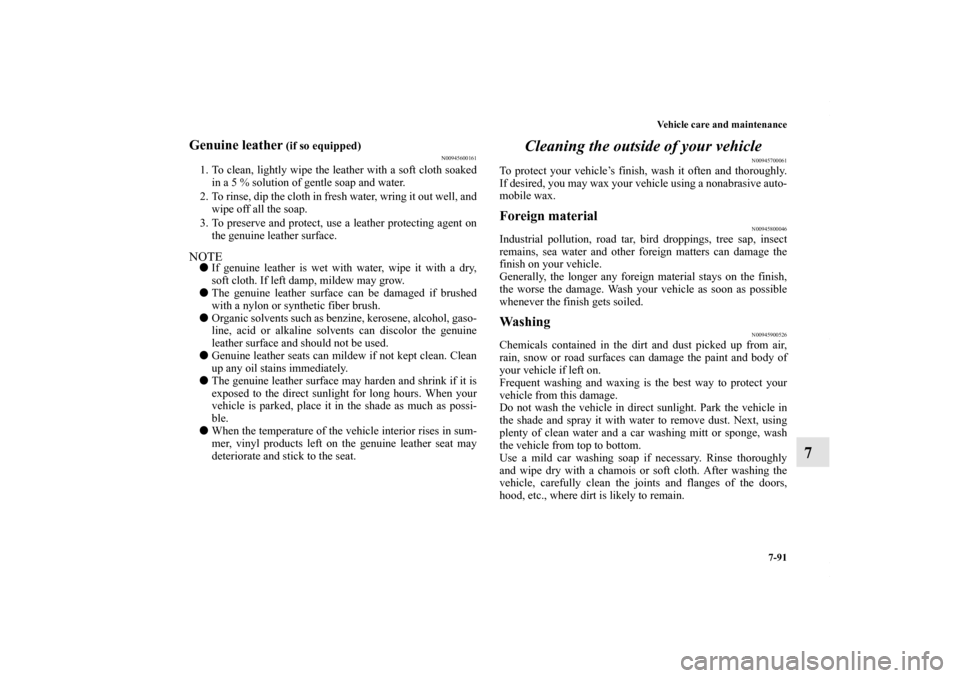Page 552 of 670

Vehicle care and maintenance
7-9
7
Vehicles with turbocharger
NOTE�Engine oil consumption is greatly influenced by payload,
engine speed, etc.
�The engine oil will deteriorate rapidly if the vehicle is
subjected to severe conditions (for example, repeated
operation on rough roads, in mountainous regions, on
roads with many uphill and downhill gradients, or over
short distances). Consequently, the oil will require earlier
replacement in accordance with the schedule in the
“WARRANTY AND MAINTENANCE MANUAL”.
CAUTION
!�Overfilling the crankcase will cause oil aeration and
loss of oil pressure, which could damage the engine.�For vehicles with turbocharger, engine oil must be
properly maintained to avoid engine and/or turbo-
charger damage. To better protect your engine and
turbocharger, use fully synthetic engine oil.
Good
WARNING
!�Used engine oil is poisonous, and can damage your
skin. Prolonged and repeated contact may cause
serious skin disorders, including dermatitis and can-
cer. Don’t let used oil touch your skin. Wash thor-
oughly after working with it.�Keep used oil out of the reach of children.
BK0102103US.book 9 ページ 2009年10月26日 月曜日 午後1時38分
Page 633 of 670

7-90 Vehicle care and maintenance
7Cleaning the inside of your vehicle
N00945200079
After washing the inside of your vehicle with any cleaner, wipe
it dry in a shady, well ventilated area. NOTE�Always read the instructions on the cleaner label.Plastic, vinyl leather, fabric and flocked parts
N00945300139
1. Lightly wipe these off with a soft cloth soaked in a 3 %
solution of gentle soap and water.
2. Dip cloth in fresh water and wring out well. Using this
cloth, wipe off the detergent thoroughly.NOTE�Do not use cleaners, conditioners, or protectants contain-
ing silicone or wax.
Such products may cause annoying reflections and
obscure vision.
Upholstery
N00945500131
1. To maintain the value of your new vehicle, maintain the
upholstery carefully and keep the interior clean.
Use a vacuum cleaner and brush to clean the seats. If
stained, vinyl and synthetic leather should be cleaned with
an appropriate cleaner. Cloth fabrics can be cleaned with
either upholstery cleaner or a 3 % solution of gentle soap
in lukewarm water.
2. Clean the carpeting with a vacuum cleaner and remove
any stains with carpet cleaner. Oil and grease can be
removed by lightly dabbing with a clean white cloth and
spot remover. NOTE�If fuzzing is difficult to remove from the seat upholstery,
draw a suitable defuzzing brush over the surface in one
direction.
CAUTION
!�Do not use organic substances (solvents, benzine,
kerosene, alcohol, gasoline, etc.) or alkaline or acidic
solutions.
These chemicals can cause discoloring, staining or
cracking of the surface.
If you use cleaners or polishing agents, make sure
their ingredients do not include the substances men-
tioned above.
BK0102103US.book 90 ページ 2009年10月26日 月曜日 午後1時38分
Page 634 of 670

Vehicle care and maintenance
7-91
7
Genuine leather
(if so equipped)
N00945600161
1. To clean, lightly wipe the leather with a soft cloth soaked
in a 5 % solution of gentle soap and water.
2. To rinse, dip the cloth in fresh water, wring it out well, and
wipe off all the soap.
3. To preserve and protect, use a leather protecting agent on
the genuine leather surface. NOTE�If genuine leather is wet with water, wipe it with a dry,
soft cloth. If left damp, mildew may grow.
�The genuine leather surface can be damaged if brushed
with a nylon or synthetic fiber brush.
�Organic solvents such as benzine, kerosene, alcohol, gaso-
line, acid or alkaline solvents can discolor the genuine
leather surface and should not be used.
�Genuine leather seats can mildew if not kept clean. Clean
up any oil stains immediately.
�The genuine leather surface may harden and shrink if it is
exposed to the direct sunlight for long hours. When your
vehicle is parked, place it in the shade as much as possi-
ble.
�When the temperature of the vehicle interior rises in sum-
mer, vinyl products left on the genuine leather seat may
deteriorate and stick to the seat.
Cleaning the outside of your vehicle
N00945700061
To protect your vehicle’s finish, wash it often and thoroughly.
If desired, you may wax your vehicle using a nonabrasive auto-
mobile wax. Foreign material
N00945800046
Industrial pollution, road tar, bird droppings, tree sap, insect
remains, sea water and other foreign matters can damage the
finish on your vehicle.
Generally, the longer any foreign material stays on the finish,
the worse the damage. Wash your vehicle as soon as possible
whenever the finish gets soiled.Wa s h i n g
N00945900526
Chemicals contained in the dirt and dust picked up from air,
rain, snow or road surfaces can damage the paint and body of
your vehicle if left on.
Frequent washing and waxing is the best way to protect your
vehicle from this damage.
Do not wash the vehicle in direct sunlight. Park the vehicle in
the shade and spray it with water to remove dust. Next, using
plenty of clean water and a car washing mitt or sponge, wash
the vehicle from top to bottom.
Use a mild car washing soap if necessary. Rinse thoroughly
and wipe dry with a chamois or soft cloth. After washing the
vehicle, carefully clean the joints and flanges of the doors,
hood, etc., where dirt is likely to remain.
BK0102103US.book 91 ページ 2009年10月26日 月曜日 午後1時38分